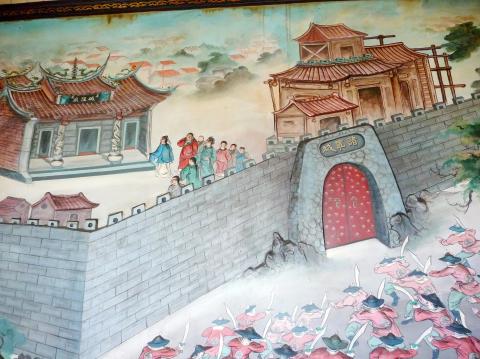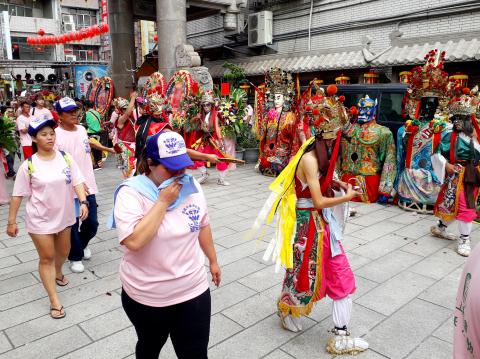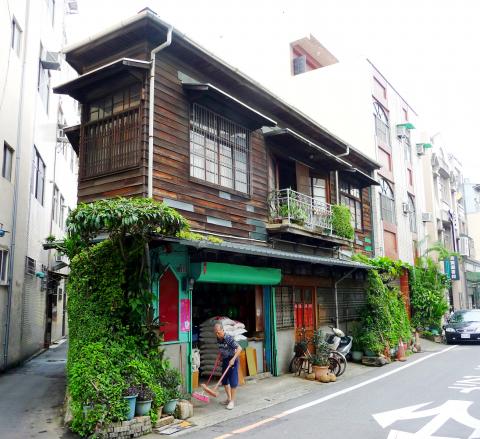Chiayi City gets short shrift from travel writers. That international travelers reaching the municipality tend to immediately head west (to see water birds near the coast) or east (for Alishan and other highland destinations) is both a cause and a consequence. Yet, within 1.5km of the train station, those willing to explore on foot will find a neighborhood awash with history and human activity.
Strolling east along Jhongshan Road (中山路) and then Gongming Road (公明路) will bring you to Wufong North Road (吳鳳北路). If you’ve read a bit about the history of relations between Taiwan’s Han majority and the island’s indigenous minority, the last name may well catch your eye. Wu Fong (吳鳳), a merchant born in Fujian in 1699, settled in a mainly Aboriginal part of Chiayi. According to legend, he died in 1769 after being ambushed by indigenous headhunters.
For a couple of generations after World War II, the way in which school children in Taiwan were taught about the circumstances of his death deprecated Aboriginal people. In some cases, Han students were inspired to bully indigenous classmates, claiming they were avenging Wu’s murder. The legend was removed from textbooks in 1989, but there seems no pressure to change the name of this road.

Photo: Steven Crook
If you turn right and move south on Wufong North Road, very soon you’ll see the grand pailou (牌樓) gateway that stands in front of the city god temple. Chiayi’s Cheng Huang Temple (城隍廟, cheng meaning city wall, huang meaning moat) is a good bit larger — and far taller — than its more famous counterparts in Tainan and Hsinchu. On the left, directly beneath the gateway, inscribed panels bear the names of those who helped fund the shrine’s 1990 renovation. Almost 3,000 donors are listed according to how much they gave. For many, the amount must have been over a week’s salary.
Between the temple’s founding in 1715 and 1895, when Japan took control of Taiwan, newly-appointed imperial officials slept, ate and prayed inside the shrine while taking part in soul-purifying rites before they assumed their posts. When Japan launched the Kominka Movement (皇民化運動), an effort to shift Taiwanese culture closer to that of Japan, the temple’s existence was threatened. In the end, the colonial authorities razed or converted to other uses 63 of the 66 major public shrines then standing in Chiayi; this place of worship was one of three they spared.
Cheng Huang Ye (城隍爺), the city’s protecting deity, is in the very center on the first floor. High above the altar, almost lost in the gloom and soot, there’s a four-character bian (扁, “inscribed tablet”) presented to the temple in 1887 on behalf of the Qing emperor. It reads Tai Yang Xian You (臺洋顯佑) and means “Protector of Taiwan and the Ocean.” No other city god in Taiwan received similar imperial recognition of his power and benevolence.

Photo: Steven Crook
In the chamber behind, you can see spirit images of Mazu (in the center) and Cheng Huang Ye’s wife (on the petitioner’s right). Guanyin is the center of attention of the second floor. If you go behind her shrine you’ll find, facing out the back of the temple, a large oil painting that depicts a key event in the city’s history.
In 1786, the Taiwan branch of an anti-Qing secret society rose in rebellion. The uprising was led by Lin Shuang-wen (林爽文), and his followers quickly took control of much of central and southern Taiwan. Chiayi, then known as Zhuluoshan (諸羅山), was besieged for several months, but thanks to Cheng Huang Ye’s intervention, the settlement never fell into rebel hands.
The painting is an enthrallingly bad piece of art. The perspective is way out of kilter. The smug faces of the men turning their backs on the rebel army are as ugly as the botched restoration that put Spain’s Santuario de Misericordia Church on the map some years back.

Photo: Steven Crook
If you take the stairs up to the very top (the sixth floor) you’ll pass shrines devoted to Old Man Under the Moon (月下老人, heaven’s matchmaker), and the Sanqing (三清, Taoism’s highest god, sometimes called the “Three Pure Ones”).
Every morning, the neighborhood immediately east of the temple is jammed with market vendors and motorcycles. Several shops specialize in pickles or handmade noodles. The upper stories of several older buildings hereabouts are made of wood.
A minor historical attraction is Red-Hair Well (紅毛井) on the corner of Jhongsiao Road and Lanjing Street (蘭井街). Long sealed up, this well was excavated by the Dutch in 1657, and used by locals until around 1909, when the colonial authorities decided the water was no longer fit for drinking.

Photo: Steven Crook
In the middle of the market turmoil, there’s a place of religion that’s even older than the city god’s abode, but often devoid of worshipers. Jiayi Shuangjhong Temple (嘉邑雙忠廟) at 88 Jhongsiao Road is one of 16 in Taiwan dedicated to Zhang Hsun (張巡) and Hsu Yuan (許遠), two ministers celebrated for their unflagging loyalty to the Tang Dynasty more than 1,200 years ago. Chang and Hsu’s birthdays are celebrated on, respectively, the eighth day of the twelfth lunar month and the eighth day of the fifth lunar month.
The shrine, founded in 1689, suffered a string of indignities during the Japanese colonial period. In 1895, it was occupied by Japanese soldiers. The invaders didn’t suffer divine retribution. If anything, the opposite was true. It’s said that soldiers billeted elsewhere in Chiayi fell sick, while those in Shuangjhong Temple stayed healthy.
In 1909, the temple was taken over by a Japanese Christian evangelical group. Local followers of popular religion filed a lawsuit, and 15 years later the evangelicals were evicted. During the building’s 1939-1945 deconsecration (a result of Japan’s Kominka policy), icons and other valuable items were moved over to the Cheng Huang Temple.
Religious-art aficionados speak highly of the dragon columns in front of the temple. They date from around 1846 and are unusual in being made of terrazzo and superbly painted, rather than carved from stone.
For the average tourist, the most interesting feature may be inside, on the left as you enter. There’s an effigy of a horse god that’s kept fenced in, because otherwise its spirit is believed to run freely, trampling and eating crops. Temple-goers keep the horse supplied with sweet potatoes, grass and water to drink — essential now that Chiayi has sprawled, and the nearest farmland is quite a gallop away.
Steven Crook has been writing about travel, culture, and business in Taiwan since 1996. Having recently co-authored A Culinary History of Taipei: Beyond Pork and Ponlai, he is now updating Taiwan: The Bradt Travel Guide.

This month the government ordered a one-year block of Xiaohongshu (小紅書) or Rednote, a Chinese social media platform with more than 3 million users in Taiwan. The government pointed to widespread fraud activity on the platform, along with cybersecurity failures. Officials said that they had reached out to the company and asked it to change. However, they received no response. The pro-China parties, the Chinese Nationalist Party (KMT) and Taiwan People’s Party (TPP), immediately swung into action, denouncing the ban as an attack on free speech. This “free speech” claim was then echoed by the People’s Republic of China (PRC),

Exceptions to the rule are sometimes revealing. For a brief few years, there was an emerging ideological split between the Democratic Progressive Party (DPP) and Chinese Nationalist Party (KMT) that appeared to be pushing the DPP in a direction that would be considered more liberal, and the KMT more conservative. In the previous column, “The KMT-DPP’s bureaucrat-led developmental state” (Dec. 11, page 12), we examined how Taiwan’s democratic system developed, and how both the two main parties largely accepted a similar consensus on how Taiwan should be run domestically and did not split along the left-right lines more familiar in

Many people in Taiwan first learned about universal basic income (UBI) — the idea that the government should provide regular, no-strings-attached payments to each citizen — in 2019. While seeking the Democratic nomination for the 2020 US presidential election, Andrew Yang, a politician of Taiwanese descent, said that, if elected, he’d institute a UBI of US$1,000 per month to “get the economic boot off of people’s throats, allowing them to lift their heads up, breathe, and get excited for the future.” His campaign petered out, but the concept of UBI hasn’t gone away. Throughout the industrialized world, there are fears that

Most heroes are remembered for the battles they fought. Taiwan’s Black Bat Squadron is remembered for flying into Chinese airspace 838 times between 1953 and 1967, and for the 148 men whose sacrifice bought the intelligence that kept Taiwan secure. Two-thirds of the squadron died carrying out missions most people wouldn’t learn about for another 40 years. The squadron lost 15 aircraft and 148 crew members over those 14 years, making it the deadliest unit in Taiwan’s military history by casualty rate. They flew at night, often at low altitudes, straight into some of the most heavily defended airspace in Asia.